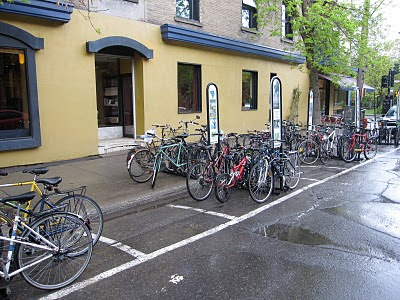Cycling in Montreal

Cycling is alive and well in Montreal.
Nancy and I spent a couple of days in Canada recently; Nancy called dances in Ottawa and Montreal and it was a tour of sorts for us. It was our first time to Ottawa and and enjoyable experience all around.
Of particular interest to me was getting an impression of cycling culture in Montreal.
With great fanfare, the spring of 2009 saw the introduction of the Bixi public bicycle sharing system, which is a coordinated arrangement of bicycles located at docking stations dispersed throughout the city. We spent most of our time in the Ste. Urban, Ste. Denis, Ste. Laurant area where the stations were to be found all over the place.
To rent the bike, you slide your debit/credit card in, are charged $5 for the first hour of use, and are given a numeric code. You then go to one of the Bixi bikes, punch in your number, the locking mechanism releases the bike, and off you go. The system is designed to encourage short rides; after your first hour of use you start paying $1.50 for each additional half hour, although --once you've paid your initial $5-- you can dock, go do something else for a while, go to another station and take another bike, even if its been a few hours. Your $5 is good for 24 hours.
The bike itself met most of the criteria I would expect of bike meant to meet the needs of a broad spectrum of riders in any conditions. The Bixi is an aluminum frame internally-geared three-speed. Built into the bike are fenders, a skirt guard over the rear wheel, a Shimano generator hub that runs flashing front and rear light and rear lights, an enclosed chain, a handlebar luggage rack, and a bell. All functional elements that make a bike versatile and useful. Missing are helmets, though I noticed many riders who brought their helmets with them to ride a Bixi.
Although there may be some questions about the merit of this project, the bikes are clearly being used (the millionth dock occurred about 4 months after the program began) and it does wonders for the public image of the city as a bicycle-friendly place.
Further indications of support for biking in the city are the designated cycling lanes built into the city streetscape. The lanes often operate like two-way bike roads with markings and traffic lights at intersections. They seem to have been carved out of the the space that was probably once the parking spaces along one side of the street.
Along one of these lanes the Maison des Cyclistes caught my eye. I ventured into the cafe but found that in addition to the cafe, this was the home of Velo Quebec, an advocacy and cycle touring organization with sleek offices and a staff. There was also a small store.
Lastly, our friends Sean and Sally were kind enough to lend us their bikes for an enjoyable cycling journey to the outdoor food market north of their place by a half hour-or-so ride. Arriving at the market, we ambled about, bought some mangos, cheese, and coffee and had a great time. Sean and Sally are the proud owners of two Dutch Gazelle bicycles brought back as luggage on the plane from a trip to Europe. They are practical and beautiful bikes.
It was a pleasure to spend time in the city and witness such a thriving bicycle culture. Every street has cyclists pouring through it, every garden gate has a bike locked to it. Bicycles are ubiquitous in the city. If anything, it was remarkable how unremarkable bicycles seem within this setting; they are everywhere.









Comments